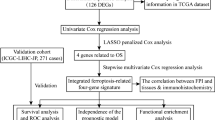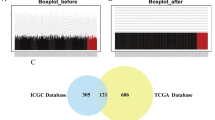Abstract
The aim of this study was to investigate the genes associated with ferroptosis and the progression of hepatocellular carcinoma (HCC). The RNA sequencing data of erastin-induced ferroptosis in HCC cells were downloaded from the Sequence Read Archive database with accession number SRP119173. The microarray dataset GSE89377 of HCC progression was downloaded from the Gene Expression Omnibus database. The ferroptosis-related genes were screened by differential analysis and HCC progression-related genes were screened by cluster analysis using Mfuzz. Then, the genes associated with ferroptosis and HCC progression were screened by Venn analysis, followed by functional enrichment, protein–protein interaction (PPI) analysis, and transcription factor (TF) prediction. Finally, survival analysis was performed using data from the Cancer Genome Atlas database. A total of 33 upregulated and 52 downregulated genes associated with HCC progression and ferroptosis were obtained, and these genes were significantly involved in the negative regulation of ERK1 and ERK2 cascades; the NAD biosynthetic process; alanine, aspartate, and glutamate metabolism; and other pathways. The PPI network contained 52 genes and 78 interactions, of which, cell division cycle 20 (CDC20) and heat shock protein family B (small) member 1 (HSPB1) were hub genes found in higher degrees. Among the 85 genes associated with HCC progression and ferroptosis, two TFs (activating TF 3 (ATF3) and HLF) were predicted, with HSPB1 targeted by ATF3. In addition, 26 genes that were found to be significantly correlated with the overall survival of HCC patients were screened, including CDC20 and thyroid hormone receptor interactor 13. Several genes associated with HCC progression and ferroptosis were screened based on a comprehensive bioinformatics analysis. These genes played roles in HCC progression and ferroptosis via the negative regulation of the ERK1 and ERK2 cascades; the NAD biosynthetic process; and alanine, aspartate, and glutamate metabolism. ATF3 and HSPB1 played important roles in HCC progression and ferroptosis, with HSPB1 possibly regulated by ATF3.







Similar content being viewed by others
Availability of data and materials
The datasets generated during the current study are not publicly available but obtained from corresponding authors on reasonable request.
References
Dixon SJ, Lemberg KM, Lamprecht MR, Skouta R, Zaitsev EM, Gleason CE, Patel DN, Bauer AJ, Cantley AM, Yang WS, Morrison B 3rd, Stockwell BR. Ferroptosis: an iron-dependent form of nonapoptotic cell death. Cell. 2012;149:1060–72.
Hirschhorn T, Stockwell BR. The development of the concept of ferroptosis. Free Radical Biol Med. 2019;133:130–43.
Xie Y, Hou W, Song X, Yu Y, Huang J, Sun X, Kang R, Tang D. Ferroptosis: process and function. Cell Death Differ. 2016;23:369–79.
Yu H, Guo P, Xie X, Wang Y, Chen G. Ferroptosis, a new form of cell death, and its relationships with tumourous diseases. J Cell Mol Med. 2017;21:648–57.
Shen Z, Song J, Yung BC, Zhou Z, Wu A, Chen X. Emerging strategies of cancer therapy based on ferroptosis. Adv Mater. 2018;30:e1704007.
Hassannia B, Vandenabeele P, Vanden-Berghe T. Targeting ferroptosis to iron out cancer. Cancer cell. 2019;35:830–49.
Liang C, Zhang X. Recent progress in ferroptosis inducers for cancer therapy. Adv Mater. 2019;31:e1904197.
Villanueva A. Hepatocellular Carcinoma. N Engl J Med. 2019;380:1450–62.
Grandhi MS, Kim AK, Ronnekleiv-Kelly SM, Kamel IR, Ghasebeh MA, Pawlik TM. Hepatocellular carcinoma: from diagnosis to treatment. Surg Oncol. 2016;25:74–85.
Keating GM. Sorafenib: a review in hepatocellular carcinoma. Target Oncol. 2017;12:243–53.
Dank M, Padányi P. Systemic treatment options of primary hepatocellular carcinoma. Magyar Onkol. 2018;62:53–61.
Lachaier E, Louandre C, Godin C, Saidak Z, Baert M, Diouf M, Chauffert B, Galmiche A. Sorafenib induces ferroptosis in human cancer cell lines originating from different solid tumors. Anticancer Res. 2014;34:6417–22.
Louandre C, Marcq I, Bouhlal H, Lachaier E, Godin C, Saidak Z, François C, Chatelain D, Debuysscher V, Barbare JC, Chauffert B, Galmiche A. The retinoblastoma (Rb) protein regulates ferroptosis induced by sorafenib in human hepatocellular carcinoma cells. Cancer Lett. 2015;356:971–7.
Yuan H, Li X, Zhang X, Kang R, Tang D. CISD1 inhibits ferroptosis by protection against mitochondrial lipid peroxidation. Biochem Biophys Res Commun. 2016;478:838–44.
Jiang L, Kon N, Li T, Wang SJ, Su T, Hibshoosh H, Baer R, Gu W. Ferroptosis as a p53-mediated activity during tumour suppression. Nature. 2015;520:57–62.
Sun X, Niu X, Chen R, He W, Chen D, Kang R, Tang D. Metallothionein-1G facilitates sorafenib resistance through inhibition of ferroptosis. Hepatol (Baltim, Md). 2016;64:488–500.
Sun X, Ou Z, Chen R, Niu X, Chen D, Kang R, Tang D. Activation of the p62-Keap1-NRF2 pathway protects against ferroptosis in hepatocellular carcinoma cells. Hepatol (Baltim, Md). 2016;63:173–84.
Zhang X, Du L, Qiao Y, Zhang X, Zheng W, Wu Q, Chen Y, Zhu G, Liu Y, Bian Z, Guo S, Yang Y, Ma L, Yu Y, Pan Q, Sun F, Wang J. Ferroptosis is governed by differential regulation of transcription in liver cancer. Redox Biol. 2019;24:101211.
Kim D, Langmead B, Salzberg SL. HISAT: a fast spliced aligner with low memory requirements. Nature Methods. 2015;12:357–60.
Frankish A, Diekhans M, Ferreira AM, Johnson R, Jungreis I, Loveland J, Mudge JM, Sisu C, Wright J, Armstrong J, Barnes I, Berry A, Bignell A, Carbonell-Sala S, Chrast J, Cunningham F, Di Domenico T, Donaldson S, Fiddes IT, García-Girón C, Gonzalez JM, Grego T, Hardy M, Hourlier T, Hunt T, Izuogu OG, Lagarde J, Martin FJ, Martínez L, Mohanan S, Muir P, Navarro FCP, Parker A, Pei B, Pozo F, Ruffier M, Schmitt BM, Stapleton E, Suner MM, Sycheva I, Uszczynska-Ratajczak B, Xu J, Yates A, Zerbino D, Zhang Y, Aken B, Choudhary JS, Gerstein M, Guigó R, Hubbard TJP, Kellis M, Paten B, Reymond A, Tress ML, Flicek P. GENCODE reference annotation for the human and mouse genomes. Nucleic Acids Res. 2019;47:D766–73.
Liao Y, Smyth GK, Shi W. featureCounts: an efficient general purpose program for assigning sequence reads to genomic features. Bioinf (Oxf, Engl). 2014;30:923–30.
Smyth GK, limma: Linear models for microarray data, bioinformatics & computational biology solutions using R & Bioconductor; 2011. pp. 397–420.
Kumar L, Mfuzz EF. a software package for soft clustering of microarray data. Bioinformation. 2007;2:5–7.
da Huang W, Sherman BT, Lempicki RA. Systematic and integrative analysis of large gene lists using DAVID bioinformatics resources. Nature Protocols. 2009;4:44–57.
Szklarczyk D, Franceschini A, Wyder S, Forslund K, Heller D, Huerta-Cepas J, Simonovic M, Roth A, Santos A, Tsafou KP, Kuhn M, Bork P, Jensen LJ, von Mering C. STRING v10: protein-protein interaction networks, integrated over the tree of life. Nucleic Acids Res. 2015;43:D447–52.
Bandettini WP, Kellman P, Mancini C, Booker OJ, Vasu S, Leung SW, Wilson JR, Shanbhag SM, Chen MY, Arai AE. MultiContrast Delayed Enhancement (MCODE) improves detection of subendocardial myocardial infarction by late gadolinium enhancement cardiovascular magnetic resonance: a clinical validation study. J Cardiovasc Magn Res. 2012;14:83.
Shannon P, Markiel A, Ozier O, Baliga NS, Wang JT, Ramage D, Amin N, Schwikowski B, Ideker T. Cytoscape: a software environment for integrated models of biomolecular interaction networks. Genome Res. 2003;13:2498–504.
Tyner C, Barber GP, Casper J, Clawson H, Diekhans M, Eisenhart C, Fischer CM, Gibson D, Gonzalez JN, Guruvadoo L, Haeussler M, Heitner S, Hinrichs AS, Karolchik D, Lee BT, Genome The UCSC. The UCSC Genome Browser database: 2017 update. Nucleic Acid Res. 2017;45:D626–34.
Schott C, Graab U, Cuvelier N, Hahn H, Fulda S. Oncogenic RAS mutants confer resistance of RMS13 rhabdomyosarcoma cells to oxidative stress-induced ferroptotic cell death. Front Oncol. 2015;5:131.
Yagoda N, Von Rechenberg M, Zaganjor E, Bauer AJ, Yang WS, Fridman DJ, Wolpaw AJ, Smukste I, Peltier JM, Boniface JJ. RAS–RAF–MEK-dependent oxidative cell death involving voltage-dependent anion channels. Nature. 2017;447:865–9.
Hou L, Huang R, Sun F, Zhang L, Wang Q. NADPH oxidase regulates paraquat and maneb-induced dopaminergic neurodegeneration through ferroptosis. Toxicology. 2019;417:64–73.
Yang WS, SriRamaratnam R, Welsch ME, Shimada K, Skouta R, Viswanathan VS, Cheah JH, Clemons PA, Shamji AF, Clish CB, Brown LM, Girotti AW, Cornish VW, Schreiber SL, Stockwell BR. Regulation of ferroptotic cancer cell death by GPX4. Cell. 2014;156:317–31.
Zhang Y, Tao X, Jin G, Jin H, Wang N, Hu F, Luo Q, Shu H, Zhao F, Yao M, Fang J, Cong W, Qin W, Wang C. A Targetable Molecular Chaperone Hsp27 confers aggressiveness in hepatocellular carcinoma. Theranostics. 2016;6:558–70.
Eto D, Hisaka T, Horiuchi H, Uchida S, Akagi Y. Expression of HSP27 in hepatocellular carcinoma. Anticancer Res. 2016;36:3775–9.
Sun X, Ou Z, Xie M, Kang R, Fan Y, Niu X, Wang H, Cao L, Tang D. HSPB1 as a novel regulator of ferroptotic cancer cell death. Oncogene. 2015;34:5617–25.
Song X, Xie Y, Kang R, Hou W, Sun X, Epperly MW, Greenberger JS, Tang D. FANCD2 protects against bone marrow injury from ferroptosis. Biochem Biophys Res Commun. 2016;480:443–9.
Distéfano AM, Martin MV. Heat stress induces ferroptosis-like cell death in plants. J Cell Biol. 2017;216:463–76.
Chen C, Ge C, Liu Z, Li L, Zhao F, Tian H, Chen T, Li H, Yao M, Li J. ATF3 inhibits the tumorigenesis and progression of hepatocellular carcinoma cells via upregulation of CYR61 expression. J Exp Clin Cancer Res. 2018;37:263.
Weng S, Zhou L, Deng Q, Wang J, Yu Y, Zhu J, Yuan Y. Niclosamide induced cell apoptosis via upregulation of ATF3 and activation of PERK in hepatocellular carcinoma cells. BMC gastroenterology. 2016;16:25.
Wang L, Liu Y, Du T, Yang H, Lei L, Guo M, Ding HF, Zhang J, Wang H, Chen X, Yan C. ATF3 promotes erastin-induced ferroptosis by suppressing system Xc(). Cell Death Differ. 2020;27:662–75.
Nakagomi S, Suzuki Y, Namikawa K, Kiryu-Seo S, Kiyama H. Expression of the activating transcription factor 3 prevents c-Jun N-terminal kinase-induced neuronal death by promoting heat shock protein 27 expression and Akt activation. J Neurosci. 2003;23:5187–96.
Li J, Gao JZ, Du JL, Huang ZX, Wei LX. Increased CDC20 expression is associated with development and progression of hepatocellular carcinoma. Int J Oncol. 2014;45:1547–55.
Zhu MX, Wei CY, Zhang PF, Gao DM, Chen J, Zhao Y, Dong SS, Liu BB. Elevated TRIP13 drives the AKT/mTOR pathway to induce the progression of hepatocellular carcinoma via interacting with ACTN4. J Exp Clin Cancer Res. 2019;38:409.
Ju L, Li X, Shao J, Lu R, Wang Y, Bian Z. Upregulation of thyroid hormone receptor interactor 13 is associated with human hepatocellular carcinoma. Oncol Rep. 2018;40:3794–802.
Zhuang L, Yang Z. Upregulation of BUB1B, CCNB1, CDC7, CDC20, and MCM3 in tumor tissues predicted worse overall survival and disease-free survival in hepatocellular carcinoma patients. Biomed Res Int. 2018;2018:7897346.
Acknowledgements
The authors gratefully acknowledge the database available to us for this study.
Funding
This work was supported by the Zhejiang Medical and Health Technology Projects (No. 2020KY300).
Author information
Authors and Affiliations
Contributions
All authors participated in the conception and design of the study; conceived the manuscript: HS and YX; wrote the paper: HS, YX and ZJ; processed the data: YL and ZF; drew figures: ZJ; all authors read and approved the paper.
Corresponding author
Ethics declarations
Conflict of interests
The authors declare that no conflicts of interest exist.
Additional information
Publisher's Note
Springer Nature remains neutral with regard to jurisdictional claims in published maps and institutional affiliations.
Electronic supplementary material
Below is the link to the electronic supplementary material.
Supplemental Figure 1.
Venn diagram shows the DEGs in chronic hepatitis vs. normal, cirrhosis vs. normal, and HCC vs. normal groups (TIFF 477 kb)
Supplemental Table 2.
Obtained clean reads from the SRP119173 dataset (XLS 18 kb)
Supplemental Table 3.
DEGs in erastin vs. control, and in ferrostatin vs. erastin groups (XLS 988 kb)
Supplemental Table 4.
DEGs in chronic hepatitis vs. normal, cirrhosis vs. normal, and HCC vs. normal groups (XLS 610 kb)
Supplemental Table 5.
Upregulated and downregulated HCC progression-related genes (XLS 69 kb)
Supplemental Table 6.
The 26 genes correlated with the prognosis of patients with HCC (XLS 18 kb)
Rights and permissions
About this article
Cite this article
Fei, Z., Lijuan, Y., Jing, Z. et al. Molecular characteristics associated with ferroptosis in hepatocellular carcinoma progression. Human Cell 34, 177–186 (2021). https://doi.org/10.1007/s13577-020-00431-w
Received:
Accepted:
Published:
Issue Date:
DOI: https://doi.org/10.1007/s13577-020-00431-w




